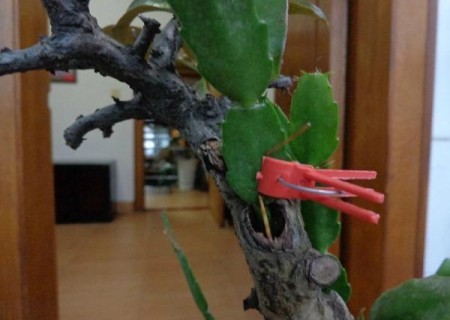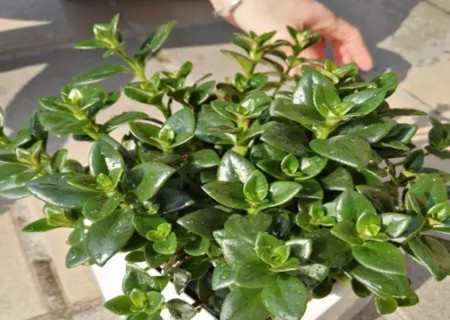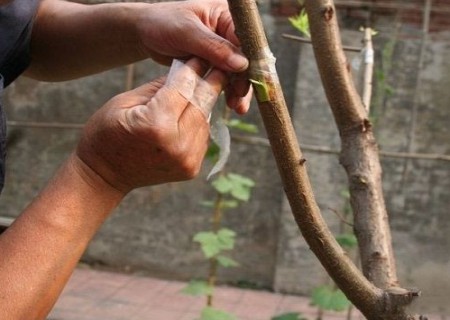Grafting Technique Illustration of Bonsai
What is grafting? Grafting is to attach some organs of one plant, such as buds or branches, to the stem or root of another plant, so that the two parts can heal each other and grow into a complete plant. The buds or branches grafted are called scions (commonly known as yards), and the plants that accept scions are called rootstocks (commonly known as mother and son, Taiwan wood, foot wood). Rootstocks mainly absorb water and inorganic salts. The seedlings obtained by grafting are called grafted seedlings.

Grafting of bonsai trees is a modeling method. Through grafting, not only excellent bonsai wood can be obtained, but also the forming speed of bonsai can be accelerated and twice the result with half the effort can be achieved. The shape of bonsai trees can be improved by grafting methods such as root filling, pruning and crown changing. In the process of bonsai modeling, the combination of flat binding, pruning and grafting techniques will play the role of icing on the cake.
The survival rate of high grafting is mainly to master the technology of grafting, and the cambium of scion and rootstock must be aligned and tied tightly. The closer the relationship between scion and rootstock is, the easier it is to survive. To master the grafting time, the most suitable temperature is 20Mel 25C, when the cambium cells are most active and divide quickly, which is conducive to the survival of grafting. The scion should select excellent mother trees with strong growth, no diseases and insect pests, small leaves and strong affinity, preferably vegetative branches with abundant tissue.
Tools should be prepared before grafting, such as bud grafting knife, cutting knife, handsaw, mallet, pruning shears, as well as bundled plastic tape, hemp skin, etc. Grafting should be as flat, accurate, fast, strict and tight technical requirements as far as possible, which can greatly improve the survival rate.
China has always liked to use grafting technology to cultivate bonsai, but the purpose is to improve the varieties of bonsai wood. If the method of grafting is used to improve the yield of fruit trees or the use of flower gardens, it is indeed understandable, and it is a technique worth popularizing. However, the use of bonsai needs to be weighed and discussed. after all, the wrong technique will leave an indelible trace of eternity.
Share a little bit of pure practical information today, including 12 grafting methods. Each method has a picture example and a text description. It is very operable. Such articles must be collected, ah, ready for a rainy day.
At present, the domestic bonsai wood is mainly made of mountain piles and coarse piles, and they are all traditional popular varieties that are easy to grow. In order to improve the diversity of varieties and the mass production of some popular varieties, bonsai manufacturers have grafted to produce many new and popular hot-selling varieties, and this goal has been achieved.
However, as a buying player, is this kind of bonsai worth collecting and playing as the industry says it is? Let's analyze this key point. I often say that bonsai art comes from the love of nature, and every detail of nature is worth learning and simulating, so bonsai should not have too many artificial traces. But grafting is just an indelible scar, as if a roadside tree has been carved with a graphic symbol by an urchin, and the artificial traces cannot be generalized with the beauty of nature expressed by it.
First of all, let's understand what grafting technology is. Grafting can be divided into many techniques, such as stakes, T-shaped buds, embedded buds and even high pressure. Let's not talk about how to do it, because this chapter is against the various disadvantages faced by bonsai using this technique.
As we all know, the high-pressure method is to take the branches directly from the mother tree and cut them off after survival. This method is aimed at some varieties that are not easy to cut and in order to propagate mature branches in order to blossom and bear fruit early. At first glance, it meets the requirements and purpose of bonsai. However, plants under high pressure do not seem to have any advantages that can be made into bonsai, except for varieties and quick flowering and fruiting. If you choose this as a material, the effect can only be cultivated in the ground, reborn after repeated sawing, and slightly coarsely shaped. Just sell a soil culture pile. This kind of material is bought back, in addition to big saws, drills and carvings, and you have many years of experience, the work is nothing more than a rotten tree covered with wounds and holes, laborious and time-consuming. The loss outweighs the gain!
The grafting pile also has similar large scars, especially the inserting pile, because the cutting branch is cut on the pile, so there is a swollen scar on the pile, if it is only half a tree and can play with a strange pile, but almost all the grafting materials leave this kind of indelible scars, so the use of this method for bonsai does not meet the requirements of the public.
Many grafts connect the joints to the branches, that is, the piles have been cultivated, and they may be popular with a new variety of the same family, so as to revive their spirits. Compared with the pile connection mentioned before, this kind of pile connection is relatively highly skilled and not easy to be found, but it still has indelible disadvantages. Because the same tree will have two different kinds of ecology, such as leaves, the leaf shape on the contact and the leaf shape germinating at the end of the pile basically belong to different varieties, although the operators will regularly cut off the original branches and leaves on the stump, after all, it is also an extra task, not to mention that customers buy it, and the technology is not in place, and it will grow out of shape three or two times.
Such a thankless method, standing on the basis of coarse cultivation, it is impossible to produce a good work up to the standard. So I personally suggest that it is best to give up this technique for bonsai production, otherwise the gain outweighs the gain.
Time: 2019-06-09 Click:
- Prev

Cutting method of goldfish orchid
Goldfish orchid is a very popular potted ornamental plant in recent years, with emerald green leaves, strange flower shape, dilated abdomen, shaped like orange-red small goldfish, extremely lovely, is a very good ornamental plant. The editor wrote an article about goldfish hanging orchids before, and flower friends are very interested, taking advantage of the warm spring season.
- Next

Diagram of branch grafting method of bonsai
Seedling grafting propagation means that the branches or buds of one plant are grafted on another plant, so that the two parts connected together become a complete plant. The branches or buds grafted are called scions, and the grounded plants are called rootstocks. Grafting can be divided into two categories: branch grafting and bud grafting, with branches as scions and buds as scions.
Related
- Fuxing push coffee new agricultural production and marketing class: lack of small-scale processing plants
- Jujube rice field leisure farm deep ploughing Yilan for five years to create a space for organic food and play
- Nongyu Farm-A trial of organic papaya for brave women with advanced technology
- Four points for attention in the prevention and control of diseases and insect pests of edible fungi
- How to add nutrient solution to Edible Fungi
- Is there any good way to control edible fungus mites?
- Open Inoculation Technology of Edible Fungi
- Is there any clever way to use fertilizer for edible fungus in winter?
- What agents are used to kill the pathogens of edible fungi in the mushroom shed?
- Rapid drying of Edible Fungi

